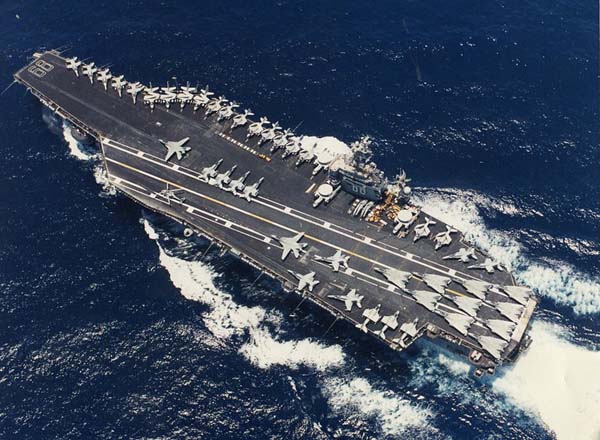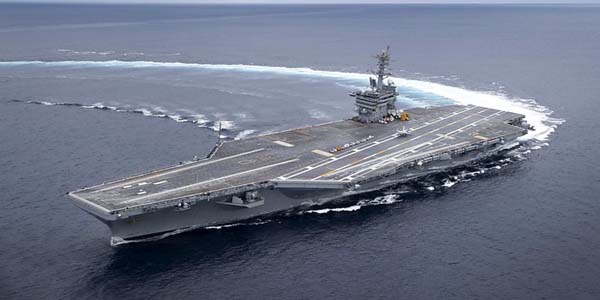Nimitz class carriers were the largest warships built in the 20th Century. There were ten ships in this class built for the US Navy, Nimitz, Dwight D Eisenhower, Carl Vinson, Theodore Roosevelt, Abraham Lincoln, George Washington, John C Stennis, Harry Trueman, Ronald Regan, and George H.W.Bush the last to enter service in 2009. The next class of US Aircraft Carrier was the Ford class with the lead ship USS. Gerald R. Ford entering service in 2017, with others to follow in 2025, 2028, 2032 and 2034. These ships are similar in size to the Nimitz class. US Carrier List. The largest Container Ships today are about 1,300 feet long, 200 feet wide, 232,618 gross tons. Largest Cruise Ships 1,181ft long, 198ft wide, 227,000 Gross Registered Tons, largest Oil Tankers 1,504ft long, 226ft wide, 260,851 Gross Registered Tons. GRT is the dimensions of a ship, length, width and height.
Large Image of the USS Nimitz next to the British carrier HMS Ark Royal at Wiki. On May 25th 1981, Nimitz was being prepared for deployment in the Mediterranean when one of her Prowler’s crash-landed on the flight deck killing 14 of the crew and injuring 45 others. During her 4th deployment to the Mediterranean in August 1981, she took part in operations in the Gulf of Sidra near what the Libyan leader Colonel Khadafi called the line of death. On the morning of the19th, two Libyan Sukhoi jets targeted two of Nimitz Tomcats. This led to the US pilots shooting down both Libyan aircraft with Sidewinder missiles.
Nimitz next deployment to a war zone was in 1988 during the Iran/Iraq war of 1980 - 1988. As both warring countries relied heavily on oil revenues, they began targeting oil tankers transporting each other’s oil. These attacks escalated in 1984 to an extent tanker’s from neutral countries were being attacked. This led to warships from around the world being deployed to the Arabian Gulf to protect tankers supplying their country. On May 17th 1987, two missiles from an Iraqi aircraft attack hit the US frigate Stark killing 37 of her crew. Soon after that attack, the United States agreed to re-flag 11 Kuwaiti tankers and protect them with their warships. The war ended August 20th 1988 after Iran agreed to a cease-fire proposed by the United Nations. Three years later, Iraq’s invasion of Kuwait led to Nimitz being returned to the Arabian Gulf to take part in Operation Desert Storm (the war to liberate Kuwait).
On September 1st 1997, Nimitz set out from her homeport of San Diego on an around the world cruise. She was intended to arrive at her builders on the east coast a few months later to undergo a mid life scheduled nuclear refueling. Following Iraq’s refusal to comply with United Nations mandates regarding arms inspection, Nimitz world cruise had to be cut short so she could support Operation Southern Watch in the Arabian Gulf (the operation to patrol the no fly zones and force Iraqi troops to stop encroaching on their neighbor’s borders). Nimitz was returned to her builders March 1st 1998 after having conducted operations in the Gulf over the New Year period. The completion of Nimitz 37-month refueling operation should allow her to continue operating out of San Diego well into the 21st Century.
|


 The
USS Abraham Lincoln by
The
USS Abraham Lincoln by 